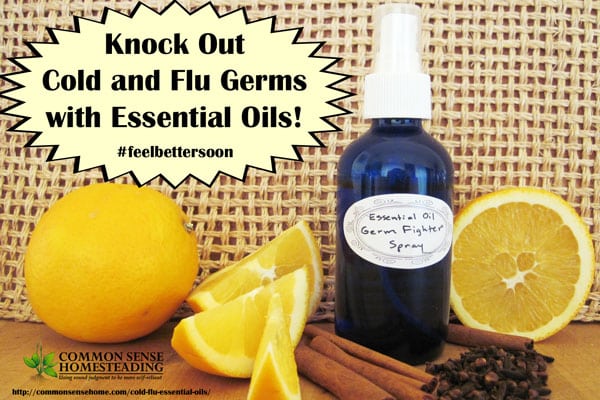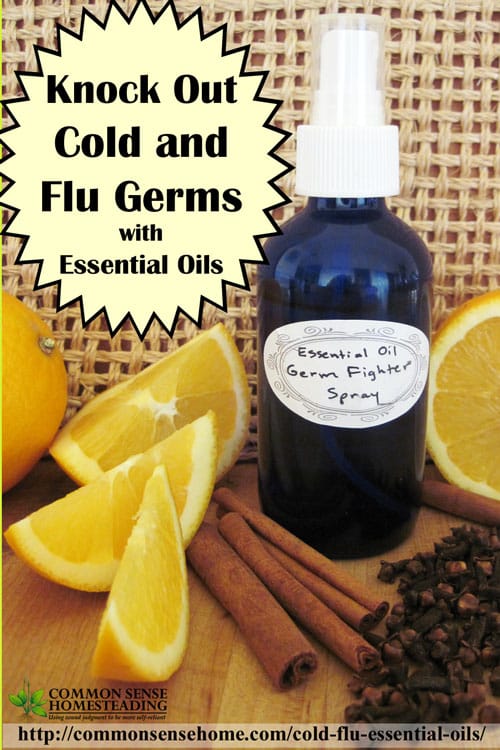Knock Out Cold and Flu Germs with Essential Oils
This post may contain affiliate links. Read my full disclosure here.
This is a guest post by Jo from Jo’s Health Corner.
This installment of cold and flu fighters will show you how to knock out cold and flu germs with essential oils. We’ll also talk about essential oil safety, since anything strong enough to kill microbes should always be used with care and respect.

What are essential oils?
Essential oils are concentrated extracts that have been distilled from aromatic trees, herbs, and grasses. They are located in leaves, stems, fruits, roots, flowers, and bark of different plants. The essential oils are responsible for the plant’s unique aroma.
Some of the most powerful anti-microbials known today
Essential oils have been used in perfume making for a long time. It is easy to overlook the important fact that essential oils are some of the most powerful anti-microbials known today. I think they should be used in every home during cold and flu season since they are very important in fighting many types of infectious disease.
It is said that glove makers and perfume makers were spared in England during the plague. The entire city of Buklesbury, England, was spared from the plague because it was the center for the lavender trade. Lavender is a known for its anti-microbial properties.
Don’t wait until you get sick
You don’t have to wait until you are sick to take advantage of the healing benefits of the oils. Most essential oils are antiseptic and bactericides, which will inhibit bacterial growth. Some oils are also anti-fungal and antiviral, so you can see why they are beneficial during flu season. You can use essential oils in many ways around the house to boost your immune system.
I like to clean with my favorite bacteria busters such as cinnamon, clove, lemon, eucalyptus, lavender, thyme and pine. Not only do they assist in cleaning my house but they also benefit my immune system. I also like to diffuse oils in my diffuser several times a day. You can make a room spritzer and spray in the air if you don’t have a diffuser.
Essential Oil Germ Fighting Spray Recipe
For a 2 ounce glass bottle with spritzer/mister top
You will need:
- 1 ¾ oz ounces of distilled water
- 10-30 drops of various essential oils ( I use less when I use intense aromas)
- Optional: ¼ teaspoon vodka or witch hazel to emulsify the oils and water. This is important with thick oils like myrrh and jasmine.
Fill the bottle with water, add oils, and shake before each use.
Make your own blend or try my favorite spice recipe:
- 2 drops cinnamon essential oil
- 1 drop clove essential oil
- 2 drops mandarin essential oil
You don’t need to buy the whole store
It is not necessary to have a whole bunch of oils at home, it is more important to choose wisely what oils to buy. The oils need to be of high quality so they posses the therapeutic properties you want. Quality is very important since many companies dilute their oils with synthetic substances to cut cost. This can cause harm and change the therapeutic effect of an oil.
I put together a list of oils that are most useful during this time of the year. You don’t need all of them, but research has shown that there is a greater antimicrobial activity when several oils were combined. Therefore, I like to mix several different oils into one blend for enhanced therapeutic value.
Essential Oils Can Act as Immune Stimulants
I make sure that I have at least a couple of different immune stimulants at home during cold and flu season. Immune stimulants can strengthen the immune system by directly inhibiting the micro-organisms, or by stimulating the immune system.
Would you like to save this?
The essential oils of lavender, eucalyptus, lemon, rosemary, tea tree and thyme are considered immune stimulants. Dr. Jan Valnet, M.D, lists eucalyptus, garlic, sandalwood, cinnamon, lavender, German Chamomile and peppermint as being very useful.
Clove, thyme, oregano, cinnamon, mountain savory, and peppermint are said to have the strongest antimicrobial actions. Tea tree, pine, patchouli, lavender, cajuput, and black pepper are other oils with antimicrobial properties.
Essential Oils Can Act as Depuratives to Help Eliminate Toxins
Get rid of the toxins! Essential oils also have depurative (cleansing) properties that eliminate waste material and toxins. Germs don’t attack healthy tissues, so it is important to keep the internal environment clean. Angelica root, carrot seed, cypress, grapefruit, juniper berry, lemon, and rosemary have depurative properties. I like to add these oils to massage oil, unscented body lotions, bath salts, and body spritzers.
Be ahead of the game and use them before you need them. Be creative in how you use the essential oils during this time of the year:
- Make Homemade Cleaners with Essential Oils
- Make your own perfume
- Diffuse oils in your diffuser
- Use the essential oils for cleaning
- Sniff straight from the bottle
- Add essential oils to lotion, liquid soap, or shampoo (make sure they don’t cause skin sensitivity)
- Add a few drops to dishwashing soap
- Put a few drops on a handkerchief and inhale
- If the oil is not contraindicated, mix with bath salts and take a healing bath
How to Use Essential Oils When Someone is Sick
There are different things you can do if you get sick. Here are some of the things that I do:
- At the first sign of a stuffy nose I inhale deeply straight from the bottle. I also diffuse appropriate oils in my diffuser
- I mix the essential oils with massage oil and apply on affected areas such as chest, sinuses, or back
- I add a few drops on a handkerchief and inhale deeply. Sometimes I put 2 or more drops into the palm of your left hand, rub clockwise with the flat palm or your right hand. Cup your hands together over the nose and mouth and inhale deeply. Don’t touch your eyes!
- My son successfully cleared congested sinuses within a few hours by doing steam inhalations with anti-viral and expectorant oils last week. Add a few drops of oil to a bowl of warm but not boiling water. Inhale the steaming vapors from the bowl. To increase intensity, drape a towel over your head and bowl before inhaling.
- I add a few drops to drinking water and gargle for a few minutes if I have a sore throat.
- I often add essential oils to the Vita Flex points on the bottom of the feet. This is especially useful for children since some oils may be too strong to apply on other parts of the body.
- I used to drop cypress under my daughter’s pillow when we lived in Wales several years ago when she was coughing a lot due to moist weather.
Essential Oil Safety
Essential oils can be used in so many various ways so be creative. As mentioned above, you don’t need a lot of oils. The best anti-microbial oils are strong and may irritate the skin so inhaling and diffusing may be better choice when used as prevention.
Oregano, cinnamon, clove, black pepper, and thyme are some of my favorite oils but I don’t apply them topically unless necessary for a specific condition. I may include them in a rub used topically for a small area, but I would not add them to a bath or a whole body massage blend.
Spice oils are very intense so it is best to mix them up with some other oils before diffusing them in the room. For example, diffused clove oil can irritate the eyes so it should not be diffused more than a couple of minutes at a time. Spice oils such as cinnamon and clove can be mixed with citrus oils to make them less irritating.
Make sure you dilute the essential oils correctly and that you’re read the safety precautions before you start. Some oils are contraindicated in certain conditions. It’s a good precaution to perform a skin patch test when using a new essential oil topically.
Also, read this before you start using essential oils. Some oils should not be applied prior to sun exposure so make sure you check this list before spending time in the sun.
This week’s installment on prepping for cold and flu season is a guest post by my friend, Jo (Johanna), from Jo’s Health Corner. Jo has a TON of great information on her site about using essential oils, and she’s shared some of her experience preparing for cold and flu season with essential oils. Johanna is an aromatherapist and she blogs about health, essential oils, real food, natural remedies, and nutrition on Jo’s Health Corner.
This post is for informational purposes only and is not intended to diagnose or treat any illness. Please exercise good judgment and see a trained healthcare provider when needed.
Other posts in this series include:
- Preparing for Cold and Flu Season: Step 1 – Probiotics
- The Best Vitamins and Minerals for Fighting Colds and Flus
- The Best Herbs and Spices for Colds and Flus – Plus a “Secret Weapon”
- Stomach Flu Treatment – Why the BRAT diet may not be your best choice
- Thieves Vinegar – Immune Booster and Germ Killer
- Herbal Antibiotics

Updated January 6, 2016.
